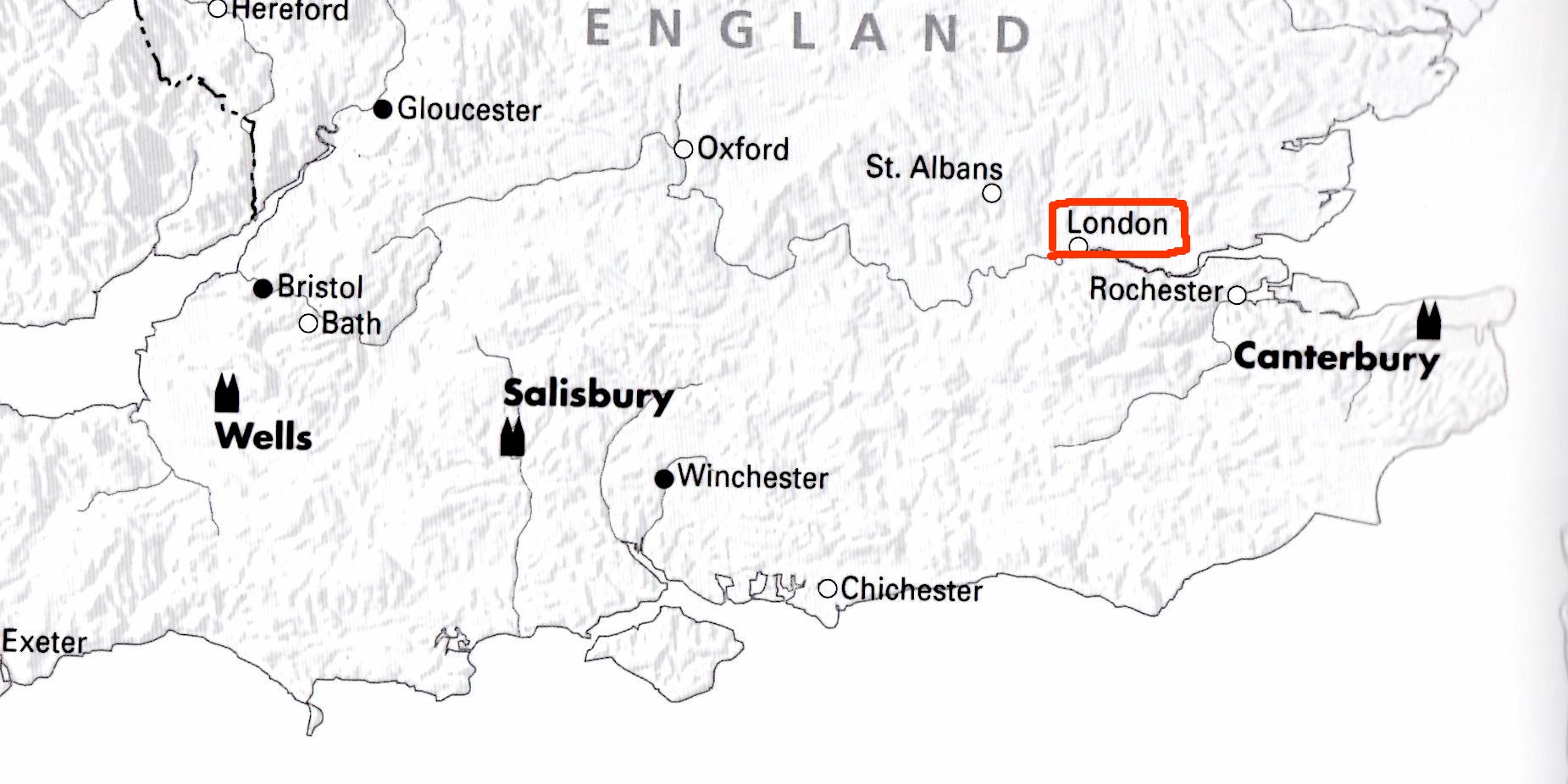
ENGLAND
2003
Day
1 , April 5, 2003 - Saturday
This was my first trans -Atlantic flight. It sure was long and rather
tiring even though I did get a little sleep on the plane. We arrived
at Heathrow at 2:00 am (our time). We took the Heathrow Express train
to Paddington station. From there we took a taxi to our hotel. We
had reservations at the Thistle Hotel located next to the Tower Bridge.
We decided to keep going rather than take a nap. We had a 2:00 pm
appointment for a private tour at St. Paulís Cathedral. It wasnít
that far away so we decided to walk plus we needed to find a place to
have something to eat Ė we didnít know whether it was breakfast or
lunch, but we were hungry. We were in an area which is part of ďThe
CityĒ Ė the original square mile and is now a financial district so
there were few restaurants open on Saturday morning. The first place
that we found was a McDonaldís. So we travel across the ocean and our
first meal on foreign soil is McDonalds.
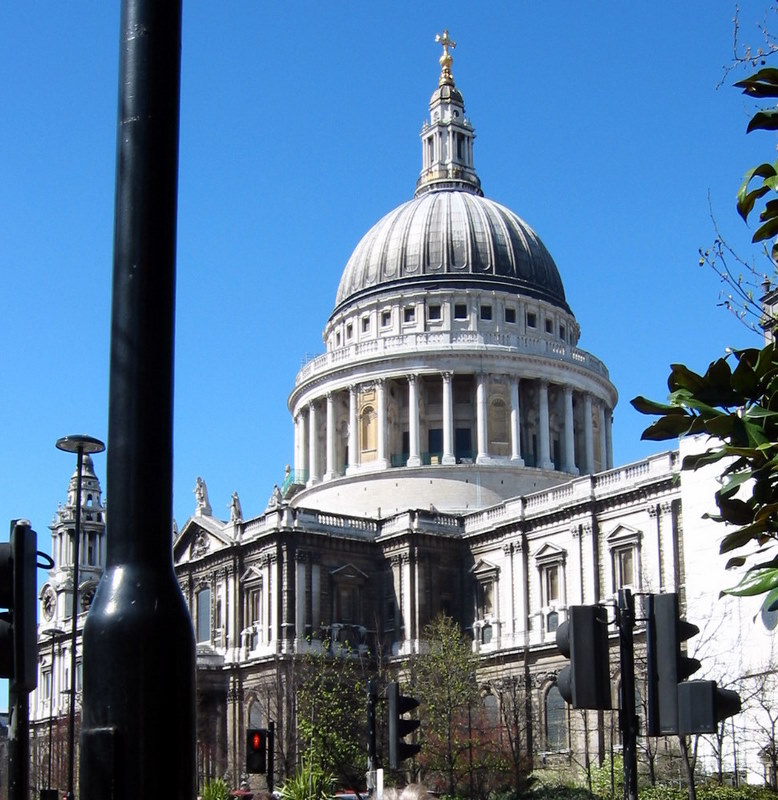 We
then walked to St. Paulís Cathedral (see
model). The architecture of St. Paulís is quite different from the
English Gothic architecture of the Washington National Cathedral. One
of first things that a visitor notes is that rather than a central
tower, this cathedral has a dome, no flying buttress nor a faÁade filled
with statuary unlike many of the cathedrals and churches in England. It
has the look of some of Palladian churches that we experienced in Venice
on our Italian CATHEDRAL QUESTS. The architectural syle is
Baroque.
We
then walked to St. Paulís Cathedral (see
model). The architecture of St. Paulís is quite different from the
English Gothic architecture of the Washington National Cathedral. One
of first things that a visitor notes is that rather than a central
tower, this cathedral has a dome, no flying buttress nor a faÁade filled
with statuary unlike many of the cathedrals and churches in England. It
has the look of some of Palladian churches that we experienced in Venice
on our Italian CATHEDRAL QUESTS. The architectural syle is
Baroque.
The main reason why St. Paulís is not a traditional Romanesque or Gothic
church, even though it has been in the same location since 604, is that
it has a long history of building, fire and rebuilding. Many of the
medieval European churches that we will visit have been restored or
added to and thus retain either their Romanesque or Gothic qualities.
Many suffered fire or war damage but were able to be restored. All of
St. Paulís building was completely destroyed by fire.
The first church, a wooden structure, was built in 604 shortly after
Augustine landed at Kent in 597. This church burned to the ground.
Between 675 and 685 a new church of stone was built on the site. This
was destroyed by the Vikings in 962 and rebuilt almost immediately.
That church burned down in 1087.
Rebuilding was started at once in the Norman style. The Norman style is
the name given to the Romanesque style of architecture in the Normandy
region in northern France. This style of architecture was brought to
England at the time of the Norman Conquest by William the Conquer in
1066.
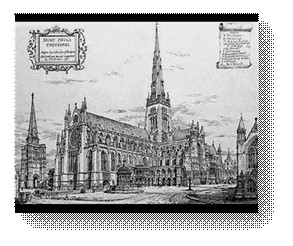 Old
St. Paulís was not completed until 1240. Almost immediate work was
begun on construction of a new choir in the
Gothic style. Gothic
architecture had its beginning at St. Denis in Paris in 1140. This
addition made St. Paulís the largest church in England and the third
largest in Europe Ė 596 feet in length. In 1315 a spire was placed on
the crossing tower.
Old
St. Paulís was not completed until 1240. Almost immediate work was
begun on construction of a new choir in the
Gothic style. Gothic
architecture had its beginning at St. Denis in Paris in 1140. This
addition made St. Paulís the largest church in England and the third
largest in Europe Ė 596 feet in length. In 1315 a spire was placed on
the crossing tower.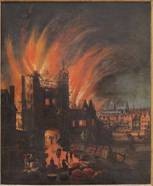 It became the tallest steeple ever built. In 1444 this spire was
destroyed by lightening. It was rebuilt but struck again a hundred
years later. The church was showing signs of deterioration and plans
were made to destroy it and rebuild it. Then in 1666 the cathedral was
destroyed in the Great Fire of London.
It became the tallest steeple ever built. In 1444 this spire was
destroyed by lightening. It was rebuilt but struck again a hundred
years later. The church was showing signs of deterioration and plans
were made to destroy it and rebuild it. Then in 1666 the cathedral was
destroyed in the Great Fire of London.
In 1668 Sir Christopher Wren was commissioned to build a new church.
Wren drew three sets of plans before they were accepted in 1673. The
new plan was based on the traditional Latin Cross of the t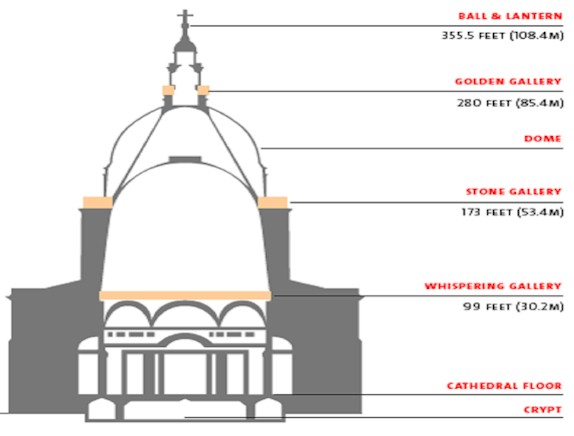 raditional
Romanesque and Gothic churches, two short transepts (the side arms), and
a dome and spire at the crossing. Domes had not been used in most
Romanesque and Gothic style churches except in Italy. Domes go back to
Eastern/Byzantine architecture of Constantinopleís Hagia Sophia's in
537. One of the first uses of a dome was the Pantheon in Rome built
between 118 and 126. The famous domes of St. Peterís, Rome; the Duomo
in Florence with Brunelleschiís Dome, and St. Markís -Venice were all
built before St. Paulís. The last stone at St. Paulís Cathedral was put
in place in 1708.
raditional
Romanesque and Gothic churches, two short transepts (the side arms), and
a dome and spire at the crossing. Domes had not been used in most
Romanesque and Gothic style churches except in Italy. Domes go back to
Eastern/Byzantine architecture of Constantinopleís Hagia Sophia's in
537. One of the first uses of a dome was the Pantheon in Rome built
between 118 and 126. The famous domes of St. Peterís, Rome; the Duomo
in Florence with Brunelleschiís Dome, and St. Markís -Venice were all
built before St. Paulís. The last stone at St. Paulís Cathedral was put
in place in 1708.
World War II bombings damaged the choir roof and destroyed the high
altar and damaged the Reredos. The restoration was completed in 1967.
Upon arriving at St. Paulís, we stopped at the information desk and
introduced ourselves. St. Paulís was one of the churches that I had
written about a private tour. Our guide, Mike, was waiting for us.
Before leaving home we bought a Washington Cathedral book to give each
cathedral. We presented Mike with a copy of the book. There were
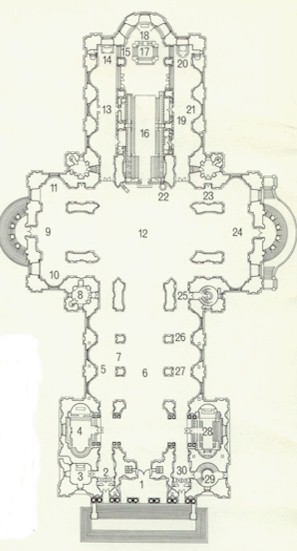 several
other people waiting for a tour, so we invited them to join us. The
inside walls were being cleaned. I think it was the same process as
used at the Washington Cathedral, which involved a mixture of clay and
toilet paper and something else. The walls are plastered with this
mixture and allowed to dry and then scraped off and the stain and
moisture comes off with the mixture. There was one wall that had been
completed but the rest of the cathedral had scaffolding and the plaster
mixture so we couldnít appreciate the real beauty of St. Paulís.
several
other people waiting for a tour, so we invited them to join us. The
inside walls were being cleaned. I think it was the same process as
used at the Washington Cathedral, which involved a mixture of clay and
toilet paper and something else. The walls are plastered with this
mixture and allowed to dry and then scraped off and the stain and
moisture comes off with the mixture. There was one wall that had been
completed but the rest of the cathedral had scaffolding and the plaster
mixture so we couldnít appreciate the real beauty of St. Paulís.
This being the first European cathedral that we had visited, we noticed
as many differences on the interior as we did on the exterior as
compared to the Washington Cathedral. There was a feeling of openness
in spite of the amount of scaffolding. The columns were large squares
rather than a series of round columns, with rounded arches rather than
pointed arches and farther apart than the Washington Cathedral. The
openness of the dome provided a lot of sunlight. Unlike the Washington
Cathedral, the ceilings were barrel vaults with gold Baroque
decorations. The inside of the dome was decorated with the monochrome
paintings of Sir James Thornhill depicting the incidents in the life of
St. Paul. We were given the opportunity to climb up in the dome, but
declined. It looked too high and had too many steps.
Another difference in the design is that the high altar is not against
the east wall of the apse as in the Washington Cathedral. At the
Washington Cathedral there is nothing behind the altar or reredos except
a room used by the altar guild. Surrounding the main altar at St. Paulís
is a structure known as baldacchino with the figure of our Lord in
triumph on the dome surrounded by four gold angels. In our future
travels we did not encounter many baldacchinos. The most famous is over
the high altar at St. Peterís in Rome. In most Gothic cathedrals there
is at least one chapel and sometimes many chapels behind the main altar
in the area known as the apse. At St.
Paulís Cathedral there is the American Memorial Chapel behind the main
altar against the east wall. This chapel is the tribute of the people
of Britain to the 28,000 Americans stationed in the United Kingdom, who
lost their lives in World War II. It is interesting that the kneeling
cushions in the War Memorial chapel in the Washington Cathedral were
made and given to the Washington Cathedral by the ladies of England in
thanksgiving for our aid during World War II. The queen is credited
with making one of them.
In the Washington Cathedral there is only one tomb in the main part of
the church and that is of Woodrow Wilson. During our tours in the next
few years we will see many large and elaborate tombs and memories in the
main part of the churches. At St. Paulís we were impressed with the
memorial to Arthur Wellesley, the first Duke of Wellington in the north
aisle. It is as tall as the nave arch with Wellesley on his horse on
the top of it. His tomb is surrounded by a series of columns. It took
twenty years to build. The crypt was also interesting with the large
memorial tomb of Lord Nelson. Our docent gave us a wonderful tour. We
are disappointed that we are unable to share photos of the interior of
St. Paulís, but taking pictures was not allowed. Please read what I
have said about photographing churches.
 We
walked along the Thames River back to the hotel. The Tower of London
(see model)was very near our hotel, but we didnít go in. The Tower of
London is a historic castle on the north bank of the River Thames. It
was founded in the winter of 1066 as part of the Norman Conquest of
England. From as early as 1100, the Tower of London was used as a
prison. Although the Tower is popularly known today as a place of
imprisonment, that was not its primary purpose. Early in its history,
the Tower was a grand palace, serving as a royal residence. From the
Tudor period onwards, the Tower was used less as a royal residence. The
height of the castle's use as a prison came in the 16th and
17th centuries, when many political or religious figures were held
within its walls. This last use has led to the phrase "sent to the
Tower". The Tower is also known as a place of torture and execution,
although only seven people were executed within the Tower.
We
walked along the Thames River back to the hotel. The Tower of London
(see model)was very near our hotel, but we didnít go in. The Tower of
London is a historic castle on the north bank of the River Thames. It
was founded in the winter of 1066 as part of the Norman Conquest of
England. From as early as 1100, the Tower of London was used as a
prison. Although the Tower is popularly known today as a place of
imprisonment, that was not its primary purpose. Early in its history,
the Tower was a grand palace, serving as a royal residence. From the
Tudor period onwards, the Tower was used less as a royal residence. The
height of the castle's use as a prison came in the 16th and
17th centuries, when many political or religious figures were held
within its walls. This last use has led to the phrase "sent to the
Tower". The Tower is also known as a place of torture and execution,
although only seven people were executed within the Tower.
We walked along the Thames River back to the hotel. The Tower of
London was very near our hotel, but we didnít go in. The Tower of London
is a historic castle on the north bank of the River Thames. It was
founded in the winter of 1066 as part of the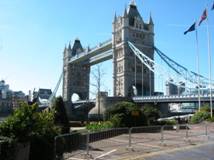 Norman Conquest of England. From as early as 1100, the Tower of London
was used as a prison. Although the Tower is popularly known today as a
place of imprisonment, that was not its primary purpose. Early in its
history, the Tower was a grand palace, serving as a royal residence.
From the Tudor period onwards, the Tower was used less as a royal
residence. The height of the castle's use as a prison came in the 16th
and 17th centuries, when many political or religious figures were held
within its walls. This last use has led to the phrase "sent to the
Tower". The Tower is also known as a place of torture and execution,
although only seven people were executed within the Tower.
Norman Conquest of England. From as early as 1100, the Tower of London
was used as a prison. Although the Tower is popularly known today as a
place of imprisonment, that was not its primary purpose. Early in its
history, the Tower was a grand palace, serving as a royal residence.
From the Tudor period onwards, the Tower was used less as a royal
residence. The height of the castle's use as a prison came in the 16th
and 17th centuries, when many political or religious figures were held
within its walls. This last use has led to the phrase "sent to the
Tower". The Tower is also known as a place of torture and execution,
although only seven people were executed within the Tower.
Near the Tower of London and our hotel was the famous Tower Bridge which
was begun in 1886 and took eight years to build.
When we checked into our hotel, our room was hot even though we had
turned on the air conditioning. It was still hot when we returned so
the hotel management changed our room to a cooler one with a king size
bed.
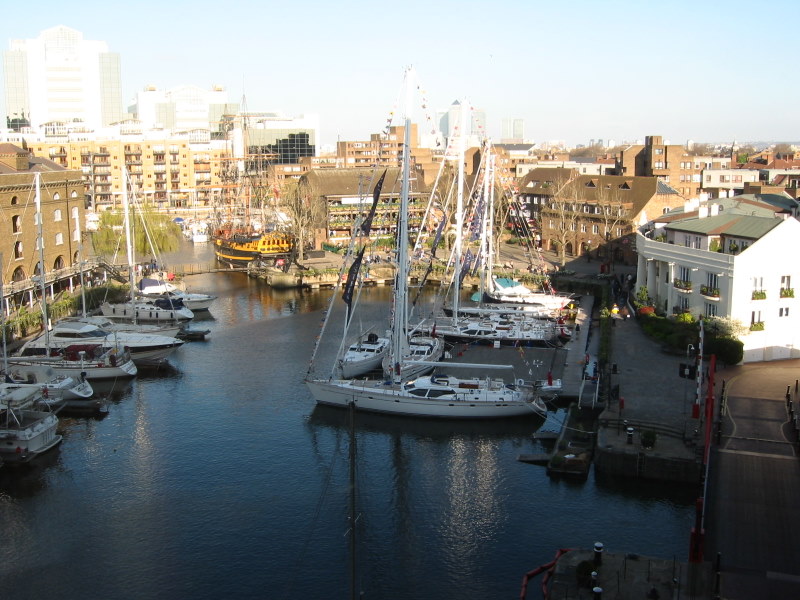 Our
room had a good view of St. Katharine Docks and Marina. St Katharine
Docks took their name from the former hospital of St Katharine's by the
Tower, built in the 12th century, which stood on the site. An intensely
built-up 23 acre site was earmarked for redevelopment by an Act of
Parliament in 1825. Some 1250 houses were demolished, together with the
medieval hospital of St. Katharine. The docks were officially opened on
25 October 1828. Although well used, they were not a great commercial
success and were unable to accommodate large ships. The St Katharine
Docks were badly damaged by German bombing during the Second World War
and never fully recovered thereafter. The docks were closed, in 1968,
and were sold to the Greater London Council. Most of the original
warehouses were demolished and replaced by modern commercial buildings
in the early 1970s, with the docks themselves becoming a marina.
Our
room had a good view of St. Katharine Docks and Marina. St Katharine
Docks took their name from the former hospital of St Katharine's by the
Tower, built in the 12th century, which stood on the site. An intensely
built-up 23 acre site was earmarked for redevelopment by an Act of
Parliament in 1825. Some 1250 houses were demolished, together with the
medieval hospital of St. Katharine. The docks were officially opened on
25 October 1828. Although well used, they were not a great commercial
success and were unable to accommodate large ships. The St Katharine
Docks were badly damaged by German bombing during the Second World War
and never fully recovered thereafter. The docks were closed, in 1968,
and were sold to the Greater London Council. Most of the original
warehouses were demolished and replaced by modern commercial buildings
in the early 1970s, with the docks themselves becoming a marina.
There were shops and restaurants around the water which contained a
number of sailboats and yachts. It was fun watching the boats enter the
locks before their journey out to the Thames. We stopped in the Thames
bar in the hotel and had a drink. Then we walked over to the famous
Dickenís Inn on the other side of marina but it was crowded with a long
wait. There was an Indian restaurant nearby but it smelled too spicy.
At this point we were really tired and just wanted something simple to
eat. We went back to the hotel and ate in the Carvery restaurant. My
wife had an omelet and I had curried chicken. We went to bed at 8:00
pm as we were really tired from the trip across the pond and a busy day
without much sleep.
NEXT DAY



 We
then walked to St. Paulís Cathedral (see
model). The architecture of St. Paulís is quite different from the
English Gothic architecture of the Washington National Cathedral. One
of first things that a visitor notes is that rather than a central
tower, this cathedral has a dome, no flying buttress nor a faÁade filled
with statuary unlike many of the cathedrals and churches in England. It
has the look of some of Palladian churches that we experienced in Venice
on our Italian CATHEDRAL QUESTS. The architectural syle is
Baroque.
We
then walked to St. Paulís Cathedral (see
model). The architecture of St. Paulís is quite different from the
English Gothic architecture of the Washington National Cathedral. One
of first things that a visitor notes is that rather than a central
tower, this cathedral has a dome, no flying buttress nor a faÁade filled
with statuary unlike many of the cathedrals and churches in England. It
has the look of some of Palladian churches that we experienced in Venice
on our Italian CATHEDRAL QUESTS. The architectural syle is
Baroque. Old
St. Paulís was not completed until 1240. Almost immediate work was
begun on construction of a new choir in the
Gothic style. Gothic
architecture had its beginning at St. Denis in Paris in 1140. This
addition made St. Paulís the largest church in England and the third
largest in Europe Ė 596 feet in length. In 1315 a spire was placed on
the crossing tower.
Old
St. Paulís was not completed until 1240. Almost immediate work was
begun on construction of a new choir in the
Gothic style. Gothic
architecture had its beginning at St. Denis in Paris in 1140. This
addition made St. Paulís the largest church in England and the third
largest in Europe Ė 596 feet in length. In 1315 a spire was placed on
the crossing tower. It became the tallest steeple ever built. In 1444 this spire was
destroyed by lightening. It was rebuilt but struck again a hundred
years later. The church was showing signs of deterioration and plans
were made to destroy it and rebuild it. Then in 1666 the cathedral was
destroyed in the Great Fire of London.
It became the tallest steeple ever built. In 1444 this spire was
destroyed by lightening. It was rebuilt but struck again a hundred
years later. The church was showing signs of deterioration and plans
were made to destroy it and rebuild it. Then in 1666 the cathedral was
destroyed in the Great Fire of London.  raditional
Romanesque and Gothic churches, two short transepts (the side arms), and
a dome and spire at the crossing. Domes had not been used in most
Romanesque and Gothic style churches except in Italy. Domes go back to
Eastern/Byzantine architecture of Constantinopleís Hagia Sophia's in
537. One of the first uses of a dome was the Pantheon in Rome built
between 118 and 126. The famous domes of St. Peterís, Rome; the Duomo
in Florence with Brunelleschiís Dome, and St. Markís -Venice were all
built before St. Paulís. The last stone at St. Paulís Cathedral was put
in place in 1708.
raditional
Romanesque and Gothic churches, two short transepts (the side arms), and
a dome and spire at the crossing. Domes had not been used in most
Romanesque and Gothic style churches except in Italy. Domes go back to
Eastern/Byzantine architecture of Constantinopleís Hagia Sophia's in
537. One of the first uses of a dome was the Pantheon in Rome built
between 118 and 126. The famous domes of St. Peterís, Rome; the Duomo
in Florence with Brunelleschiís Dome, and St. Markís -Venice were all
built before St. Paulís. The last stone at St. Paulís Cathedral was put
in place in 1708.  several
other people waiting for a tour, so we invited them to join us. The
inside walls were being cleaned. I think it was the same process as
used at the Washington Cathedral, which involved a mixture of clay and
toilet paper and something else. The walls are plastered with this
mixture and allowed to dry and then scraped off and the stain and
moisture comes off with the mixture. There was one wall that had been
completed but the rest of the cathedral had scaffolding and the plaster
mixture so we couldnít appreciate the real beauty of St. Paulís.
several
other people waiting for a tour, so we invited them to join us. The
inside walls were being cleaned. I think it was the same process as
used at the Washington Cathedral, which involved a mixture of clay and
toilet paper and something else. The walls are plastered with this
mixture and allowed to dry and then scraped off and the stain and
moisture comes off with the mixture. There was one wall that had been
completed but the rest of the cathedral had scaffolding and the plaster
mixture so we couldnít appreciate the real beauty of St. Paulís.  We
walked along the Thames River back to the hotel. The Tower of London
(see model)was very near our hotel, but we didnít go in. The Tower of
London is a historic castle on the north bank of the River Thames. It
was founded in the winter of 1066 as part of the Norman Conquest of
England. From as early as 1100, the Tower of London was used as a
prison. Although the Tower is popularly known today as a place of
imprisonment, that was not its primary purpose. Early in its history,
the Tower was a grand palace, serving as a royal residence. From the
Tudor period onwards, the Tower was used less as a royal residence. The
height of the castle's use as a prison came in the 16th and
17th centuries, when many political or religious figures were held
within its walls. This last use has led to the phrase "sent to the
Tower". The Tower is also known as a place of torture and execution,
although only seven people were executed within the Tower.
We
walked along the Thames River back to the hotel. The Tower of London
(see model)was very near our hotel, but we didnít go in. The Tower of
London is a historic castle on the north bank of the River Thames. It
was founded in the winter of 1066 as part of the Norman Conquest of
England. From as early as 1100, the Tower of London was used as a
prison. Although the Tower is popularly known today as a place of
imprisonment, that was not its primary purpose. Early in its history,
the Tower was a grand palace, serving as a royal residence. From the
Tudor period onwards, the Tower was used less as a royal residence. The
height of the castle's use as a prison came in the 16th and
17th centuries, when many political or religious figures were held
within its walls. This last use has led to the phrase "sent to the
Tower". The Tower is also known as a place of torture and execution,
although only seven people were executed within the Tower.  Norman Conquest of England. From as early as 1100, the Tower of London
was used as a prison. Although the Tower is popularly known today as a
place of imprisonment, that was not its primary purpose. Early in its
history, the Tower was a grand palace, serving as a royal residence.
From the Tudor period onwards, the Tower was used less as a royal
residence. The height of the castle's use as a prison came in the 16th
and 17th centuries, when many political or religious figures were held
within its walls. This last use has led to the phrase "sent to the
Tower". The Tower is also known as a place of torture and execution,
although only seven people were executed within the Tower.
Norman Conquest of England. From as early as 1100, the Tower of London
was used as a prison. Although the Tower is popularly known today as a
place of imprisonment, that was not its primary purpose. Early in its
history, the Tower was a grand palace, serving as a royal residence.
From the Tudor period onwards, the Tower was used less as a royal
residence. The height of the castle's use as a prison came in the 16th
and 17th centuries, when many political or religious figures were held
within its walls. This last use has led to the phrase "sent to the
Tower". The Tower is also known as a place of torture and execution,
although only seven people were executed within the Tower.  Our
room had a good view of St. Katharine Docks and Marina. St Katharine
Docks took their name from the former hospital of St Katharine's by the
Tower, built in the 12th century, which stood on the site. An intensely
built-up 23 acre site was earmarked for redevelopment by an Act of
Parliament in 1825. Some 1250 houses were demolished, together with the
medieval hospital of St. Katharine. The docks were officially opened on
25 October 1828. Although well used, they were not a great commercial
success and were unable to accommodate large ships. The St Katharine
Docks were badly damaged by German bombing during the Second World War
and never fully recovered thereafter. The docks were closed, in 1968,
and were sold to the Greater London Council. Most of the original
warehouses were demolished and replaced by modern commercial buildings
in the early 1970s, with the docks themselves becoming a marina.
Our
room had a good view of St. Katharine Docks and Marina. St Katharine
Docks took their name from the former hospital of St Katharine's by the
Tower, built in the 12th century, which stood on the site. An intensely
built-up 23 acre site was earmarked for redevelopment by an Act of
Parliament in 1825. Some 1250 houses were demolished, together with the
medieval hospital of St. Katharine. The docks were officially opened on
25 October 1828. Although well used, they were not a great commercial
success and were unable to accommodate large ships. The St Katharine
Docks were badly damaged by German bombing during the Second World War
and never fully recovered thereafter. The docks were closed, in 1968,
and were sold to the Greater London Council. Most of the original
warehouses were demolished and replaced by modern commercial buildings
in the early 1970s, with the docks themselves becoming a marina.